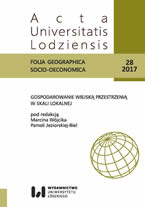Zagospodarowanie użytków rolnych na zabudowanych terenach mieszkaniowych aglomeracji poznańskiej
Development of agricultural land in built-up housing areas in the agglomeration of Poznań
Author(s): Juan José Ruiz Lendínez, Barbara Maćkiewicz, Magdalena SzczepańskaSubject(s): Agriculture, Energy and Environmental Studies, Rural and urban sociology
Published by: Wydawnictwo Uniwersytetu Łódzkiego
Keywords: Agricultural land; suburbanization; built-up housing areas; rural landscape;
Summary/Abstract: Since the beginning of the socio-economic transformation in Poland we have witnessed a steady reduction of agricultural land. It has taken place mainly as a result of the process of taking out farmland from agricultural production to be used for investment purposes. The dominant direction of this process is to create housing areas. It concerns, to great extent, rural areas which are adjacent to big cities. As a consequence, rural areas located in agglomerations are gradually losing their character both in terms of their economic functions, the structure of residents, and the landscape.This contributes to such phenomena as excessive and irrevocable loss of agricultural land including areas of high quality soils, the development of dispersed housing, the loss of rural landscape as well as problems with establishing accurate surface used for agricultural purposes. The aim of the paper is to identify how agricultural land which remains after completion of the housing construction process within the agglomeration of Poznań is developed. Our investigation concentrated on the geodetic district of Bytkowo located in Rokietnica commune which borders with the city of Poznań from the north west. The analyses were conducted basing on data obtained from Land and Buildings Records of the Poviat Centre of Geodetic and Cartographic Documentation (the real-estate cadastre) in Poznań, Spatial Information System data and information and data collected as a result of direct inventories of the plots. Conducted research revealed that the predominant majority (85%) of agricultural areas which constitute part of built-up housing lots are used mainly as lawns and recreational terrains. Compiled inventory of the plots demonstrated that only on a few of them the farmland was, at least partially, used for vegetable cultivation. This means that in great majority this type of land is used ina way which is incompatible with the cad astral information – where these areas still function as farmland. The research confirmed almost complete disappearance of traditional elements of rural gardens such as orchards,herbal gardens or already mentioned vegetable gardens and, what follows,a loss of indigenous plants especially deciduous, flowering, and productive trees and bushes. These contemporary trends in shaping backyard space located in rural areas experiencing high urbanization pressure are worrying.The gradual disappearance of tradition and symbolism of rural garden – its plant specificity, composition and function and, as a consequence, its rural landscape identity is evident. Particular worries are related to the lack of awareness of tradition or, even worse, a conscious attempt to break with this rural tradition as it is perceived negatively in the sense that it is identified with backwardness of the countryside. The tendency to copy urban standardsis further reinforced by the wide availability of plants especially of foreign origin, building and construction materials as well as lack of time for cultivation practices. Varied and all-year-round supply of fruit, vegetable sand herbs and their processed products contributes significantly to the vanishing of time-consuming backyard vegetable gardens and orchards.
Journal: Acta Universitatis Lodziensis. Folia Geographica Socio-Oeconomica
- Issue Year: 28/2017
- Issue No: 2
- Page Range: 151-164
- Page Count: 14
- Language: Polish

